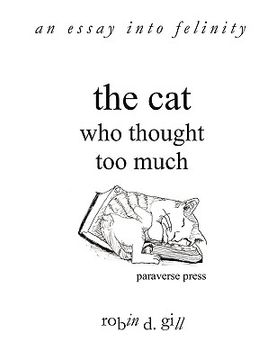Share
the cat who thought too much - an essay into felinity (in English)
Robin D. Gill
(Author)
·
Paraverse Press
· Paperback
the cat who thought too much - an essay into felinity (in English) - Gill, Robin D.
$ 23.58
$ 28.00
You save: $ 4.42
Choose the list to add your product or create one New List
✓ Product added successfully to the Wishlist.
Go to My WishlistsIt will be shipped from our warehouse between
Monday, June 03 and
Tuesday, June 04.
You will receive it anywhere in United States between 1 and 3 business days after shipment.
Synopsis "the cat who thought too much - an essay into felinity (in English)"
Imagine a cat who mastered more tricks than a highly trained dog, covered up cans of food he did not want to eat before they were opened and could delicately touch a tiny finger-spun top repeatedly without stopping it. Han-chan was such a cat. His memory, preserved in notes and sketches, inspired an authority on stereotypes of national character and translator of Edo era Japanese poetry to essay out of his fields of expertise and into felinity. Sample chapters: The animal that kneads the world. / Conversing with cats: easier in Japanese? / Smiling with closed eyes, or far from Ecotopia. /Are cats the most or least false animal. / Beauty: Is it relative or . . . is it the cat? / A little red mouse, or are we keeping the right pet? / The third-generation tanuki - a new theory of domestication. Observations are coupled with thought about things such as 1) whether the altered behavior usually explained as saving face or covering up weakness is not more like improvisation that, retrospectively, makes melodic sense of what would be wrong notes by offsetting or dream-style logic that, ever present, keeps the flow from breaking. 2) Cats, or some cats, may avoid trauma from bad experiences by convincing themselves it was only a nightmare and continuing to hope until they can cope. 3) Cats demonstrate their social nature by showing off their catches, sleeping together in the cold and behaving themselves, but most are, unfortunately, like so-called feral children: because they are separated from their family while too young to have socialized, they re-enforce the stereotype of the independent asocial cat. One can only understand felinity by living with generations of cats under one roof. The author did this. People who liked Barbara Holland's "Secrets of the Cat," the cat chapter in Vicki Hearne's "Adam's Task" and Leonard Michaels' "A Cat" will probably purr while reading this.
- 0% (0)
- 0% (0)
- 0% (0)
- 0% (0)
- 0% (0)
All books in our catalog are Original.
The book is written in English.
The binding of this edition is Paperback.
✓ Producto agregado correctamente al carro, Ir a Pagar.

